An Apple a Day: iOS 16 Medications Feature Provides Alerts, Logging, and Peace of Mind
I confess that I was amused and appalled by the massive pile of pills my grandfather had to take when I was a child. He was 61 when I was born, so well into his prescription pharmacopeia by the time I was old enough to notice. I’m embarrassed in retrospect, of course: those medications were part of what helped him live into his 90s—and I now have two full trays of pills I take daily myself! Now the shoe is on the other foot.
Over the last 25 years, I’ve been diagnosed with a series of highly treatable chronic conditions, requiring several pills that cost just pennies a day, even in the benighted US healthcare system. My primary worry has become, “Did I take that pill today? And that one? And this other one?” A failure to stay on a medication schedule can have catastrophic health consequences.
That constant struggle inspired Apple to introduce Medications, a new feature of the Health app in iOS 16 and a new app in watchOS 9. It provides users with reminders, record-keeping, and general drug information and warnings.
Medications has you start by entering all your capsules, tablets, vials, tubes of cream, inhalers, and more, including the dosage and the frequency, if not used only as needed. You can pick unique shapes for pills and capsule sides (left and right), and add colored backgrounds as visual aids. Medications also provides detailed information about each of your medications, along with known potential interactions.
Once you’ve added your medications and pill-popping schedule, the iPhone’s Health app and Apple Watch’s Medications app can remind you when to take a medication. Medications has no integration into the Reminders app, probably because it needs to work within the privacy protections of HealthKit.
Filling Your Prescription
To set up Medications, gather your prescription bottles and other medications, then follow these steps:
- In the Health app on your iPhone, tap the Browse button, and under Health Categories, tap Medications and then Add a Medication.
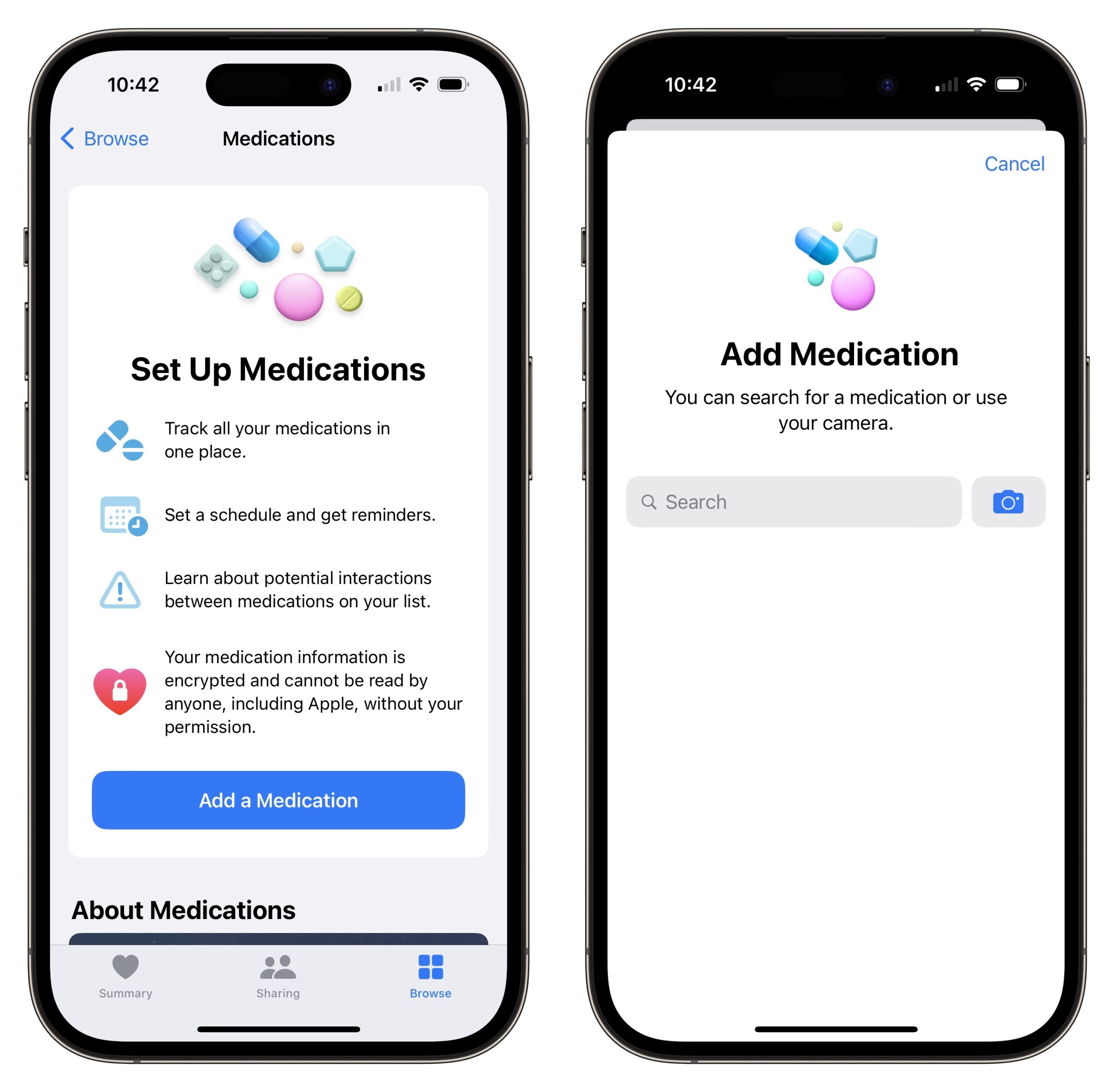
- Tap the camera button and point the camera at the NDC (National Drug Code) on your prescription bottle—every prescription and over-the-counter medication has one. In testing, this worked for all my medicine bottles. If you can’t find the NDC or Medications doesn’t correctly recognize the characters—it’s sometimes in very small type or could be blurry—you can also scan the drug name and dosage text on the label. You may have to pick the appropriate dosage, but if everything works correctly, you can skip to Step 6 to set the frequency.
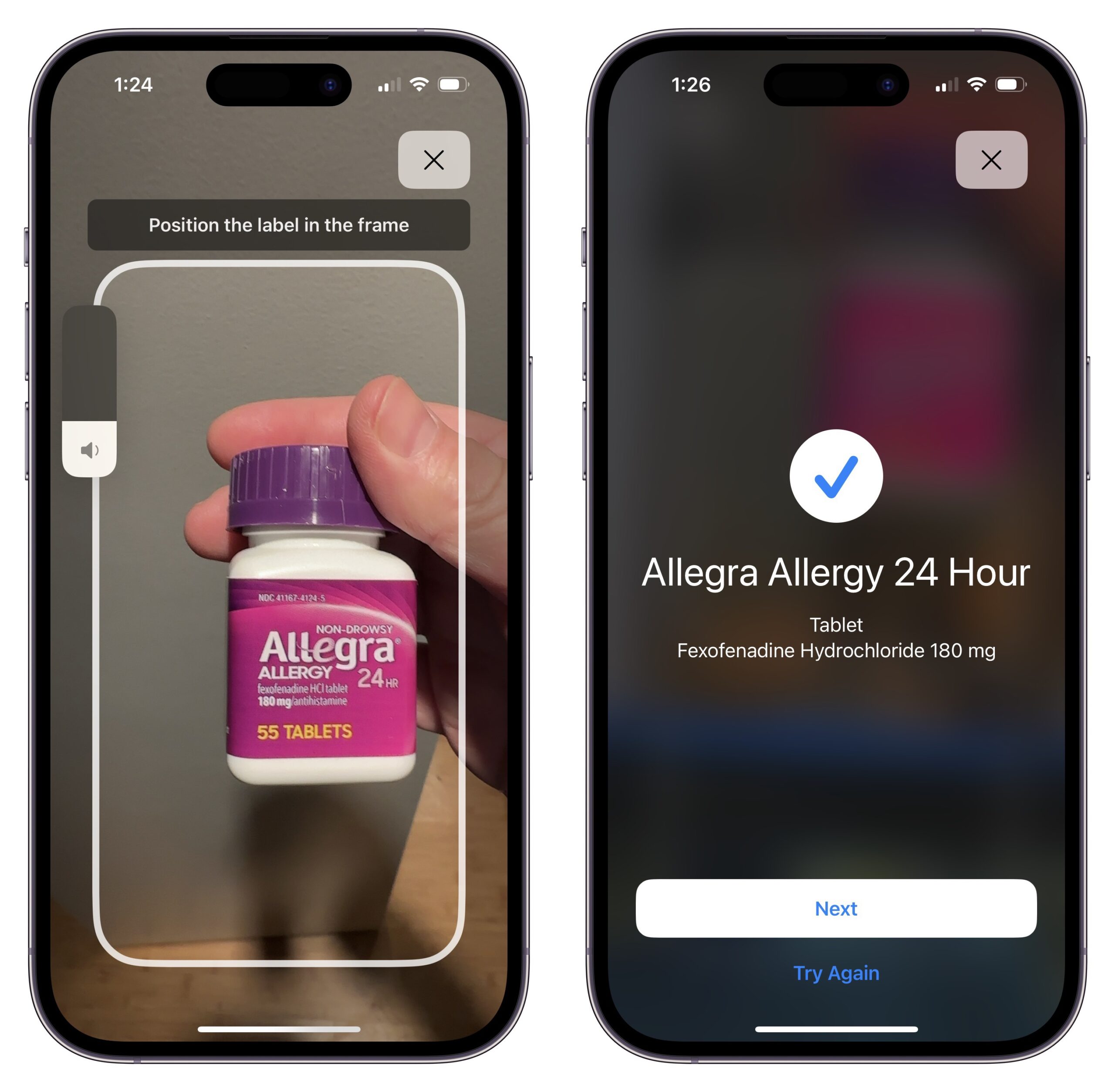
- If using the camera doesn’t work, you can search instead. Type the name of the drug exactly and tap the correct item in the list. You’ll need to enter the medication type and strength manually in the next two steps.
- Pick the medication type—tablet, capsule, etc. Apple shows the formulations in its database associated with that medication, but you can tap Show More for other options, like cream, powder, patch, liquid, and more.
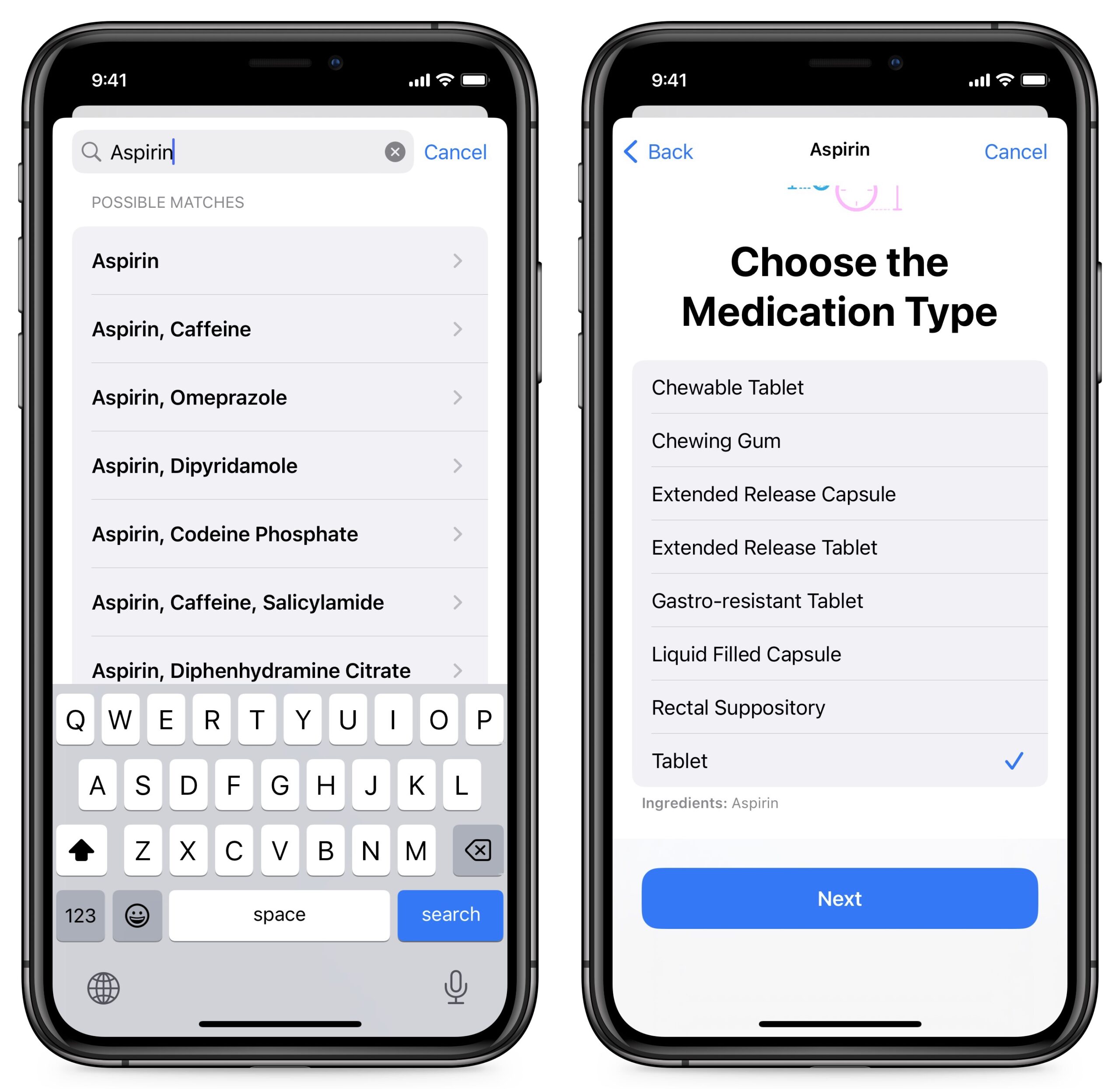
- Pick the strength or dosage. Again, Apple lists amounts associated with the medication, but you can tap Add Custom if the listed ones don’t match your prescription.
- Pick a frequency and add one or more times each day to take the drug. (If it’s a medication you take as needed, such as a pain prescription or epinephrine for bee stings, you can skip the frequency and just log it whenever you take it.)
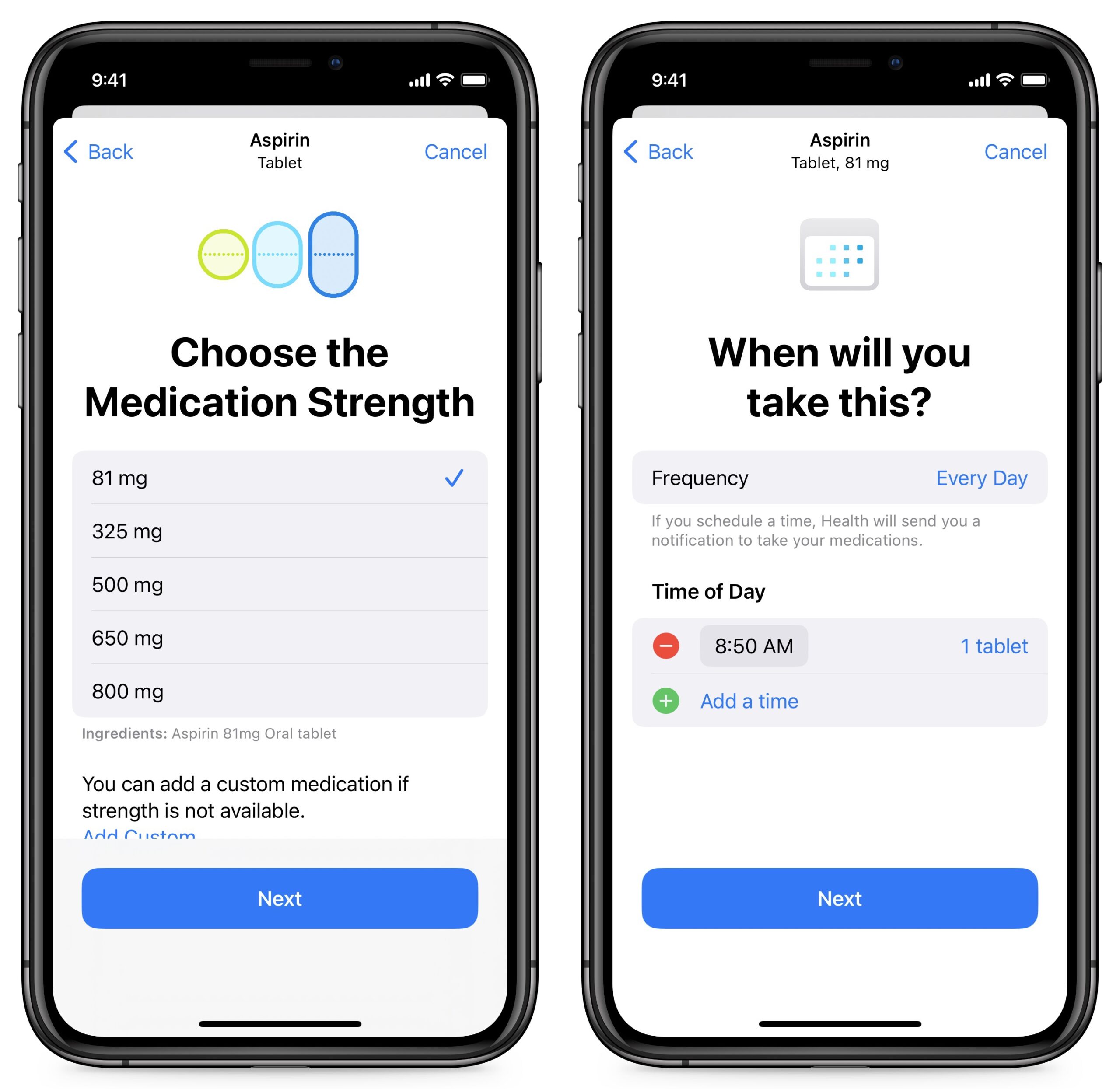
- Pick a shape that will act as a visual reminder to help you ensure you’re taking the right medication. (You can also tap Skip.)
- You can choose colors for all or parts of the medication or its container, as well as a background color.
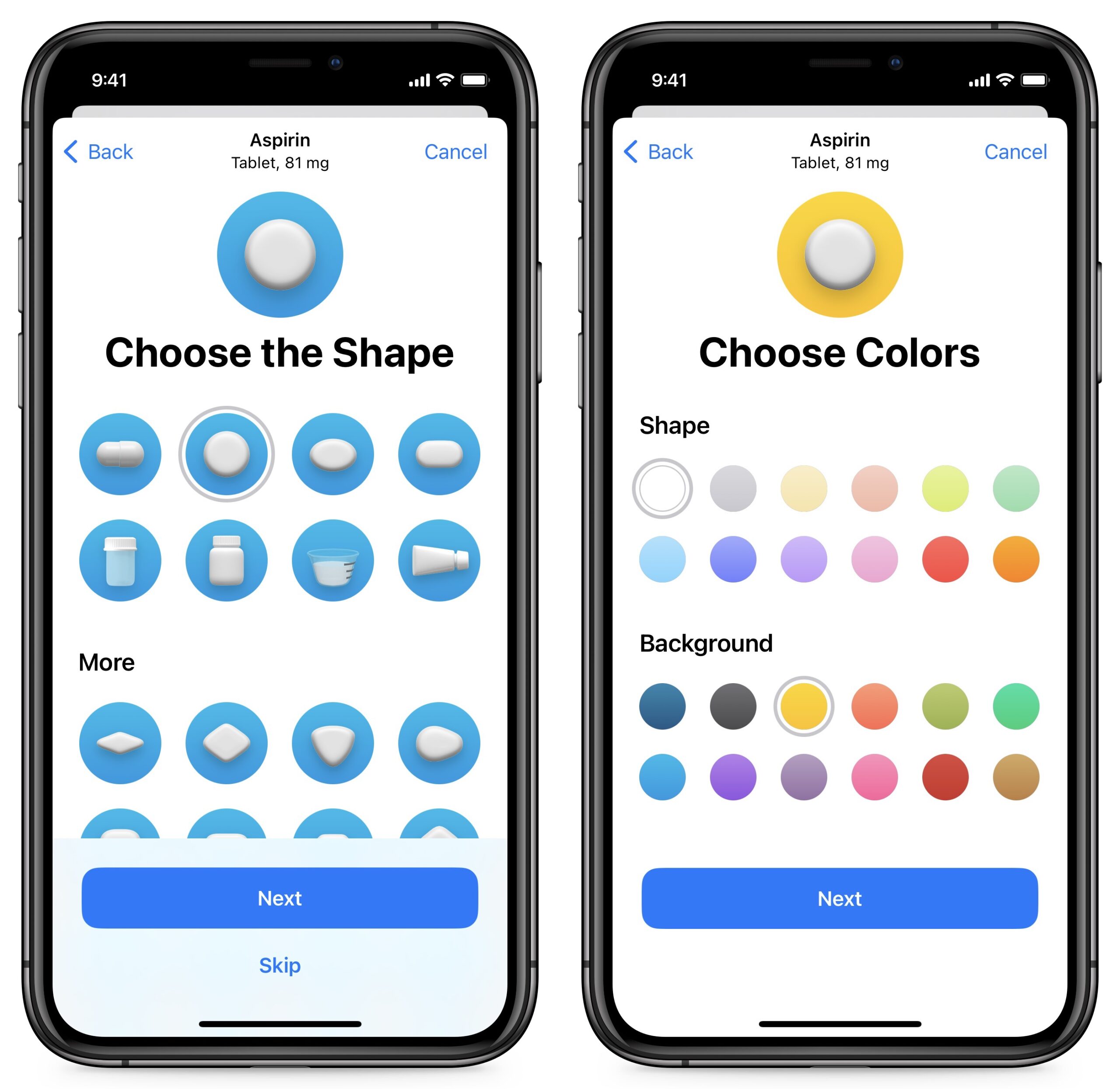
- In the final screen, you see a preview of the entry and can enter additional details, such as a Display Name to appear in the notification instead of the drug name, plus notes for yourself.
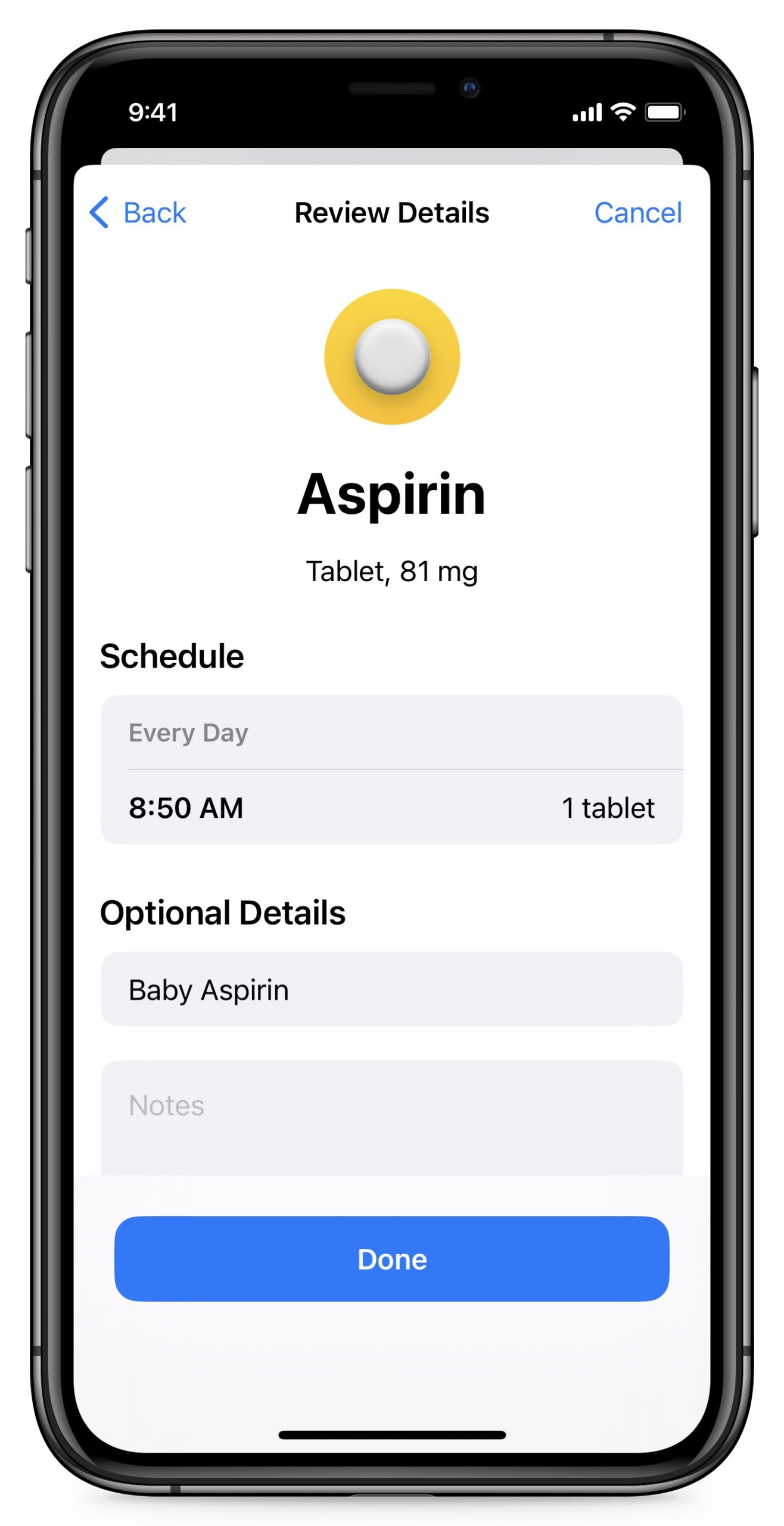
There’s one final thing to do. Because Medications relies on notifications via Health, go to Settings > Notifications > Health and make sure you have the location and style of notifications set the way you want. Swipe to the bottom of the Notifications screen and tap Options to make sure Dose Reminders is enabled. There’s also Time Zone Change, which can help you transition your medication timing when you travel to a different time zone—some medications must be taken at fairly precise intervals or times of day.
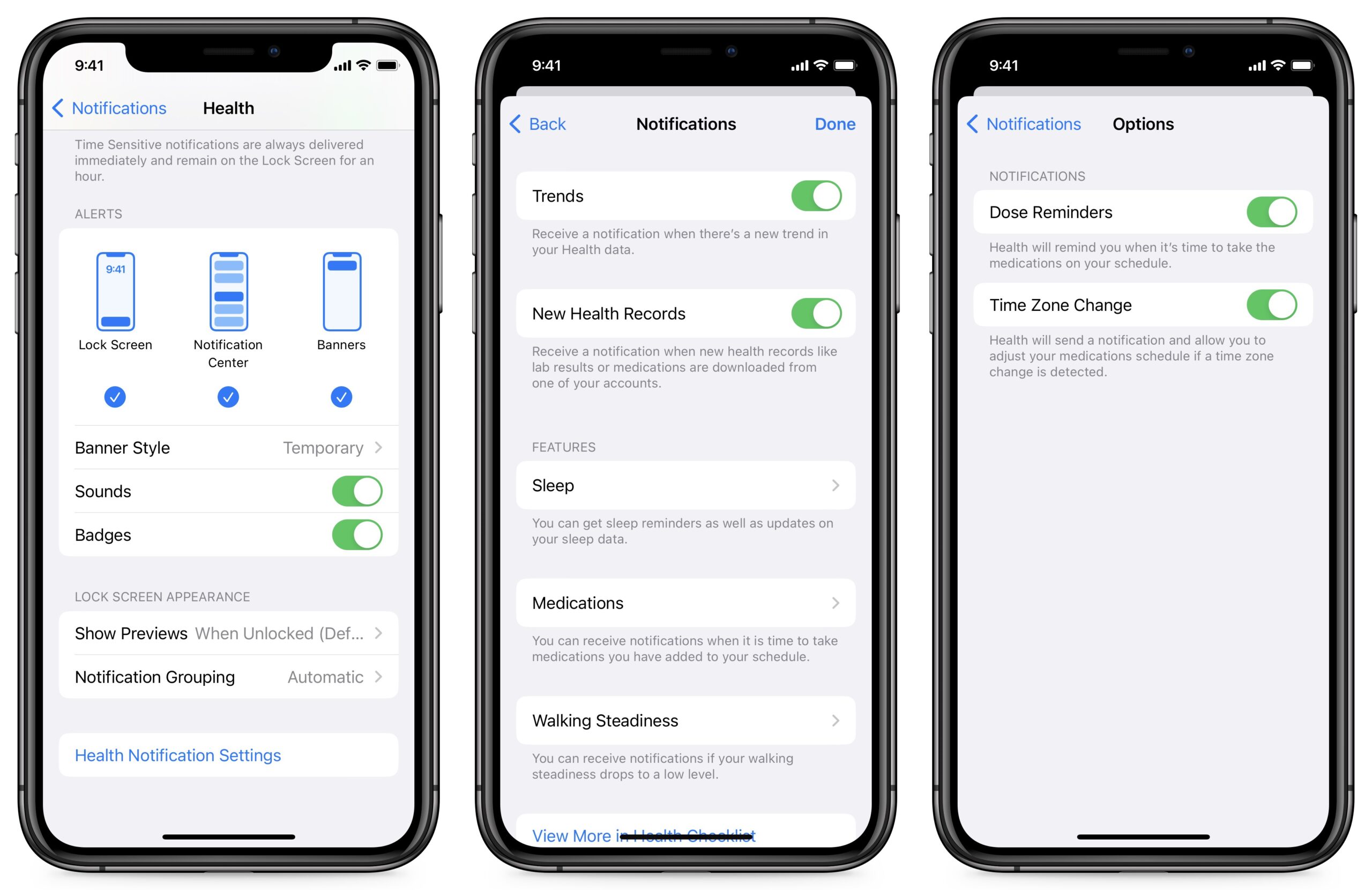
If you have an Apple Watch, it will, by default, mirror the Health app’s notifications. If that’s not desirable, open the Watch app, tap Health > Custom, and then set whether notifications should result in alerts, go to Notification Center, or not happen at all. So far, there’s no customization for Medications within the Watch app or on your Apple Watch.
Medications Notifications and Logging
When it’s time to take one or more of your medications, you receive a Health notification that contains information about what you should take. The alert appears on your iPhone and, if you use one, your Apple Watch. You can tap to log one drug or all of them if there are multiples. On an iPhone, press and hold to open the log entry within Medications, where you can adjust the time taken if it’s later than the schedule and you want an exact record.
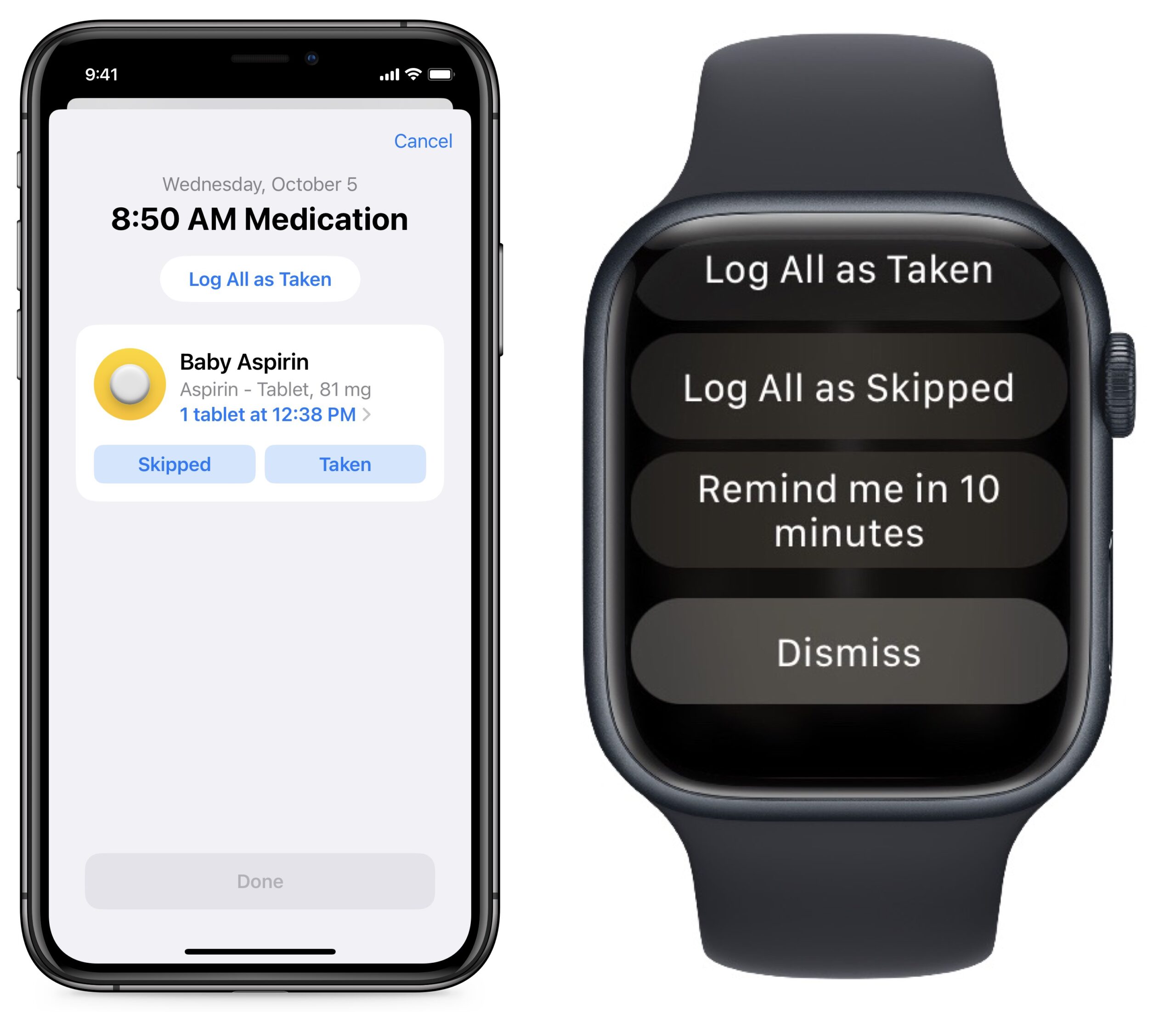
Once you’ve started using the Medications feature, the Health app divides the Medications screen into several sections:
- Calendar and log: A calendar and Log section at the top let you see the day’s set of drugs or, by tapping a previous date, how you logged taking medications on a previous day. If you’ve logged all your meds, the top entry under Log is All Scheduled Medications Logged.
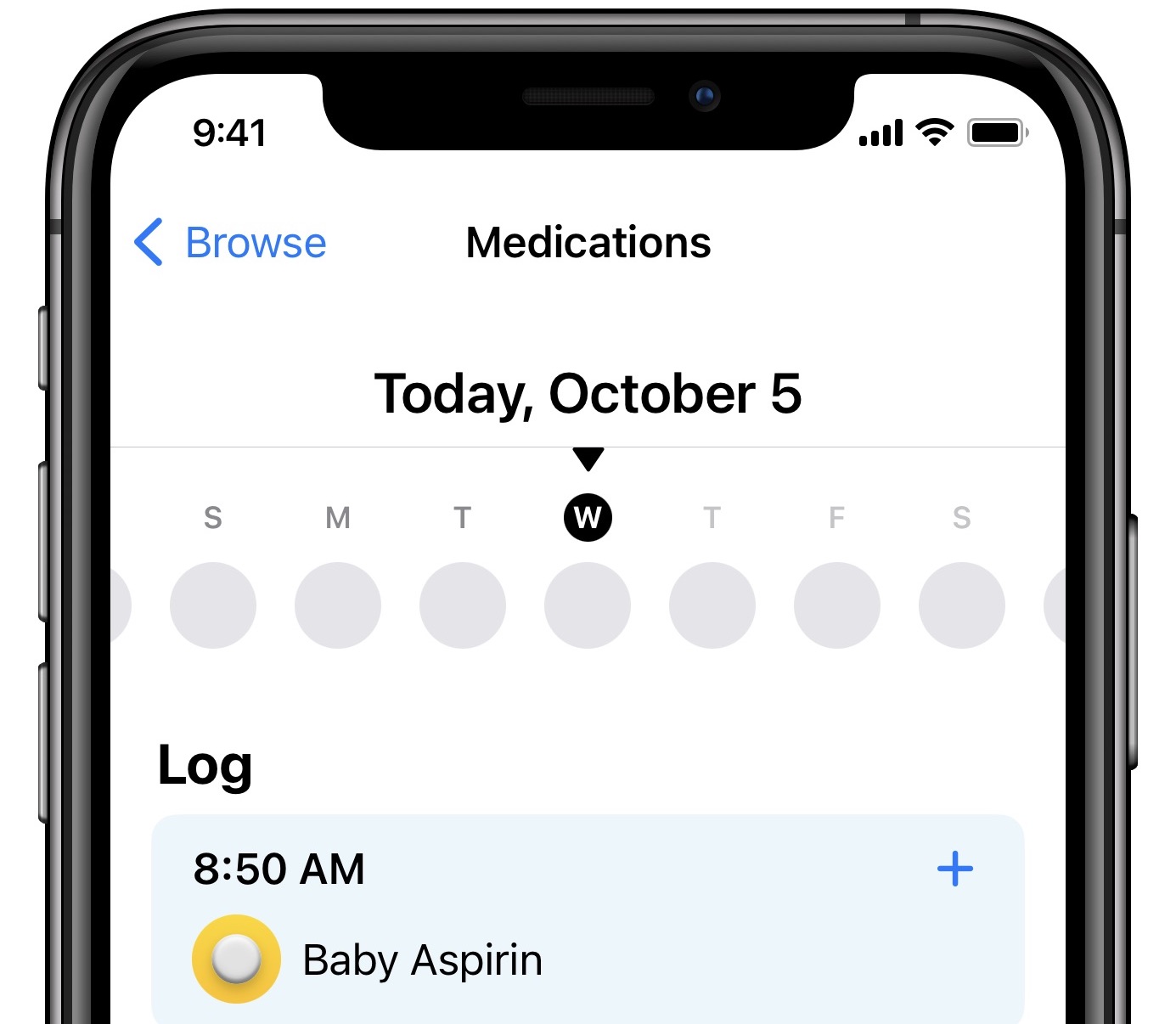
- List of medications: The next section lists all the prescriptions you configured. You can tap an entry and see your adherence by day, week, monthly, half-year, and year, plus details about the medication, including side effects.
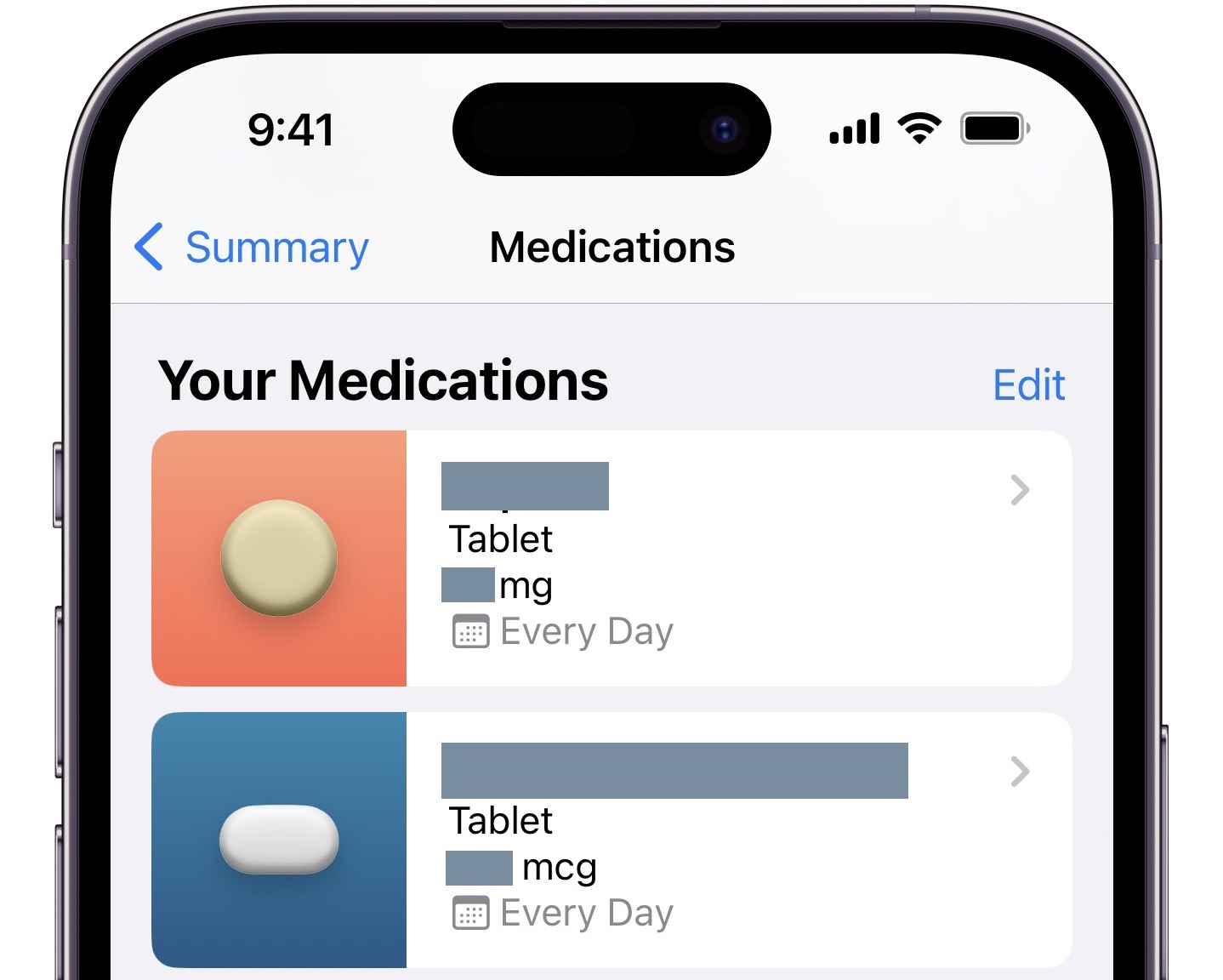
- Drug interactions: Down further, Medications reveals potential drug interactions. Tap to find database-driven alerts labeled moderate, serious, and critical. Under Interaction Factors, you can tap Edit to add alcohol, cannabis, or tobacco, and interactions are updated to include those as possible issues. Apple isn’t being diagnostic here, and your healthcare provider or pharmacist—preferably both—should already have warned you about these interactions, as they consult similar databases. If not, it would be a good idea to ask your practitioner.
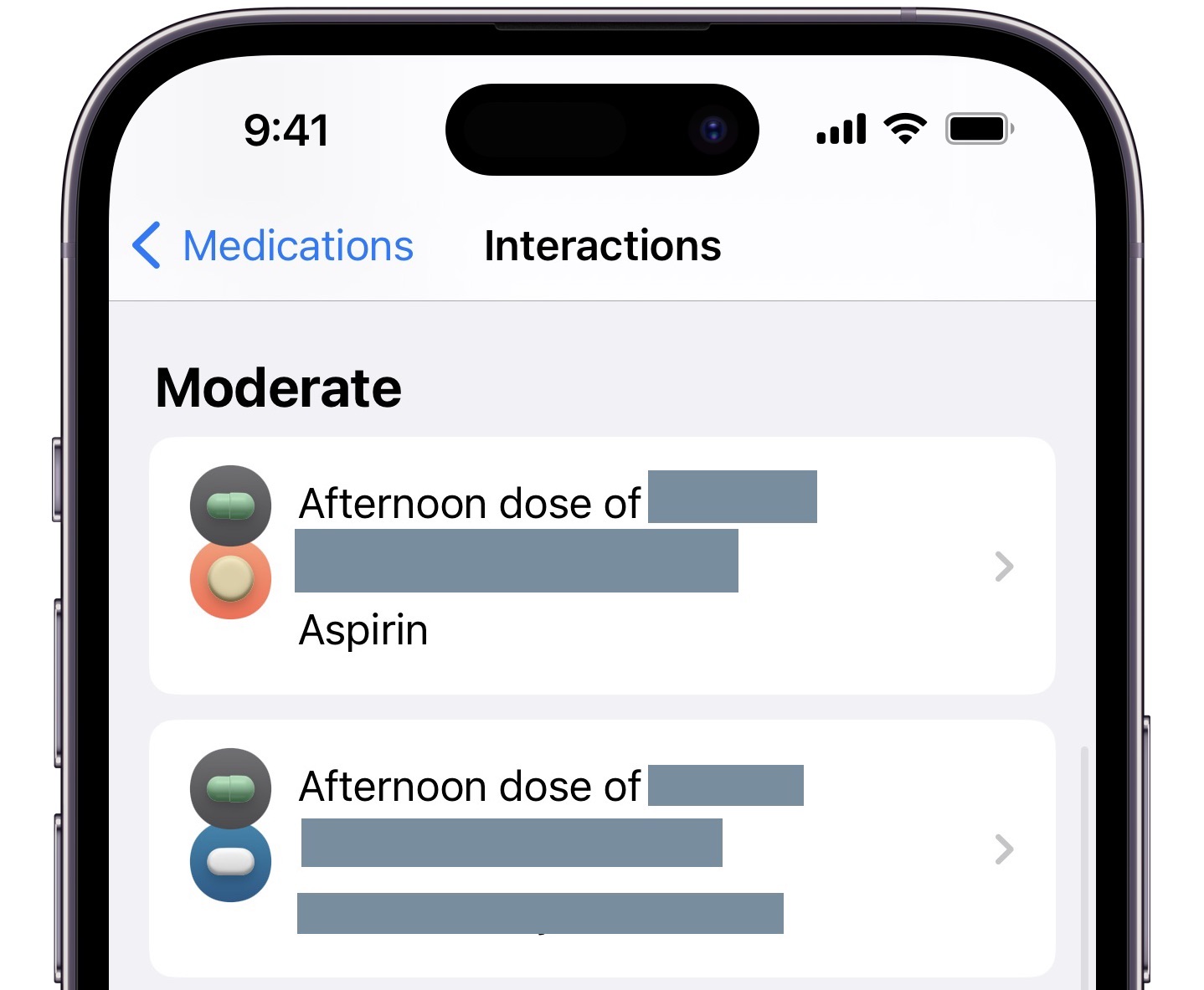
A Good Start, but Improvements Needed
Apple needs to tweak the system a bit. Most problematic is that there’s no provision for taking a time- or dose-limited course of a medication, as you might need to do with antibiotics. Plus, the Medications database is spotty when it comes to vitamins and supplements, particularly those that often appear in combinations—there are a lot of entries, but it can be tough to find one that matches what you take.
There are also notification quirks. I take one medication twice a day with other drugs, but for some reason, it’s only grouped with the morning set—at bedtime, its alert arrives separately from the set of my other evening medications. I’d also like to see its notifications becoming harder to ignore—they don’t have the same level of urgency as those from the Reminders app.
Medications has a terrific amount of utility for a new feature within an existing product. I’ve used it to replace recurring reminders that were inflexible and didn’t provide me with long-term information about how well I’m adhering to my medication schedule.
Minor quibbles aside, I have high hopes for the Medications feature because it’s sufficiently easy to set up and use, either by an iPhone owner or on behalf of someone who needs it. For adult children helping their elderly parents or parents helping their children, Medications could provide both a tool for improved health and a medical record that can help determine if an ineffective drug intervention is due to pills not being taken properly.
Thanks Glenn - a great step-by-step description. I will see if it is available in Australia.
Update: this was my trigger for updating to iOS 16.0.2. My 2nd gen iPhone SE is still on 15.6.1. I knew about the 15.7 security update but have been travelling for weeks and didn’t get around to updating.
Now home and just tried to update to 16.0.2 BUT the iPhone wants to install 15.7. When I agree to this it reports that it failed to update.
I have checked Josh’s article on system requirements and my phone is suitable for iOS16…
Updated update! On a hunch I tried upgrading to iOS 16.0.2 using an iMac running iTunes/Mojave. After agreeing to upload an iTunes update it worked. Now running 16.0.2 and the Medication function is available in the Health app. Thanks again Glenn.
My thanks for this excellent and very helpful article. I have prescription and OTC meds that I must take every day, some in the morning, some at night, some only when necessary, and some are seasonal. I’m very glad that it looks like I can eliminate Reminders and the spiral bound notebooks I’ve been using for decades to keep track.
I never signed up for Medisafe or any other apps to manage medications because I am concerned about tracking and possibly having my data sold. I’m glad that this new Medications app is part of Apple Health, and that my info will live securely on my iPhone and iPad.
OK - the app works in Australia but some slight differences from Glenn’s description. It doesn’t seem to be aware of Australian medications and does not accept camera input (unless I missed something). So I had to type in the details. The UI is a bit irritating because I needed to swipe to the bottom of long pages to be able to click the NEXT button.
A neat feature under Medication Options is time zone changes. It notifies the user if a change is detected.
I agree with Glenn that a useful addition would be to introduce an optional end date/dose for short-term medications such as antibiotics.
I am not on any prescription medication, but I wonder if this feature would be even better if linked to a smart dispenser?
For whatever its worth, I used 2 other medication reminders, and now find Apple Medications to be more reliable and easier to use.
I am a diabetic and take medications for that (and other conditions) five times a day. Most are daily, but one is once a week.
The other apps I’ve used are from Walgreens (prescription reminder in their general app) and OneDrop.
The Apple app reminds me consistently on both my iPhone and Apple Watch. The other apps occasionally don’t remind me, or clicking on them on my Apple Watch sometimes doesn’t register in the actual app. So I’m happy with the new Apple medications feature of the health app.
Love it so far, but here are a few quick improvements I’d make:
Personally speaking, a smart dispenser wouldn’t fit in any of my handbags. Even if I could find one that I could squish in, there is a good chance it could dispense pills that wind up in the bottom of my bag. And it wouldn’t work with inhalers, eye drops, etc.
I have set up Due to do this for me on my iPhone / Watch. And it’s a reminder app which is excellent at being a pain in the ass to ignore, something which apparently I need. I’ll check this out but Glenn’s observation that it was gentler than regular Reminders has me doubtful.
Is there any way of exporting the log? Seems a pretty obvious thing to do, but I’ve yet to figure out how to that …
Another neat feature would be to be able to set up alarms when a medication was not taken for more than X min — and send an alert to your ICE person.
Likewise, be able to set up alerts when medication was taken — and send that to your ICE contact.
(Two use cases of the IBM personal health toolkit back in 2005)
The same in New Zealand: all I can do is to type in a medication name and tap “Next”, then select from a list of medication types. The list of types I see is far shorter than the list in Glenn’s article.
Remember that this isn’t covered by HIPAA.
Not sure what that means. HealthKit data is end-to-end encrypted, so Apple can’t access it. Similar to passwords and other E2EE data.
Interesting. I looked up the format for the NDC coding and found this:
How is the NDC formatted?
The 10-digit NDC will be in one of the following configurations: 4-4-2, 5-3-2, or 5-4-1, meaning that there are 4 or 5 digits for the labeler code, 4 or 3 digits for the product code and 2 or 1 digit(s) for the package code.
So I went and pulled my prescriptions & an OTC bottle of a pain medication to check. The OTC has the proper format of “NDC” followed by the 10 digit code in one of the above configuration. HOWEVER, my prescriptions do NOT have anything in the mandated format on them! The closest is a barcode with 1 group of 10 digits below it. It looks like I’m going to have to call Express-Scripts and ask why they don’t have the proper NDC coding.
Well, Express- Scripts wasn’t that helpful saying they print the manufacturer’s name rather than the NDC. Then when they gave me the purported NDC for the medication, it was 11 digits rather than 10. Using the FDA’s search and trying different search terms, I found an NDC for the medication from that manufacturer but it did NOT match the one given me by the pharmacist!
Oh, I found a problem with setting up the Medications: the interval. Apple assumes fixed times using actual hours & minutes, but my prescription uses terms like “morning”, “evening”, “night”, “Take with food”, etc. I don’t eat breakfast, lunch, or supper at fixed times by the clock, so there needs to be settings of “morning”, “midday”, “evening”, “night”, and so on. My plastic weekly meds counter with daily “AM” & “PM” compartments will work better than Apple’s new “feature”.
I take a few meds regularly and so I tried the new Medications feature and like Glenn, I’d say it needs work. I’m Canadian and there is no camera option or database info provided. You can only add the information manually. I’ve been using an app called Pill Reminder for some time now and it works much better. Simpler interface and it also reminds me when it’s time to refill my meds as well as having the watch reminder. I’ll stick with it for now as I find the Apple Medication reminder feature a little “clunky”. Perhaps designed by someone that doesn’t actually take meds daily. Regardless, great article Glenn, thanks for the walk through!
Thanks for the recommendation for Pill Reminder. I’ve just searched the App Store and there are several with that name. Which do you use please? Jan
In the App Store it is called Pill Reminder - All in One. I started with the free version and ended up buying the full version. The current version is 5.0 and the developer website is aidaorganizer.com
Hopefully this helps.
Having used Reminders for some years to help overcome my inability to remember life sustaining meds (ok, a bit of an exaggeration, but I really should not miss them), I was then screwed by Reminders on my iPad updating itself to a version incompatible with what is running on my main Mac (Pro, running Mojave) and no way back. So medication reminders have been a problem for some time and the news Apple were incorporating it into iOS was welcome news and I updated to iOS 16 ASAP.
However, like others have mentioned in this thread, for me there is NO camera icon to enable the use of the camera to assist with adding meds. and in my case basically no suggestions while typing either. After an aggravating few hours while I tried to figure out what was wrong, I gave up and just had to add all the meds. manually. No big thing I realise, but Apple have touted this as being such a terrific help and showing how we can simply use the camera to add meds. so being inexplicably unable to do that was, well, disappointing, to say the least.
It is now clear, from comments above, that there are several significant markets that are not allowed to have the assistance of the camera, nor smart meds. recognition. Apparently Canada and Australia and in my case, the UK. Probably others too.
I can accept that for one reason or another, it may have been impossible to incorporate such assistance in all markets, but what I find UNacceptable is that Apple make no mention of this lack and simply proclaim how great it is to be able to do this, while failing to mention that it is only possible in some parts of the world. Why can they not be upfront and honest about it and save us poor users from wasting valuable time trying to figure what we (or our Apple devices) are doing wrong.
That aside, the new Medications functionality certainly needs work. I saw mentioned elsewhere that a different meds. app provides a simple option to log having taken the meds. at the prescribed time and I think Apple need to incorporate that. Very rarely do I have an appropriate device at hand to log taking each medication, so usually I end up logging taking them at some time later. At which time I have to either faff about selecting the actual time they were taken, or accept that the log will be incorrect. A quick option (button) to log having taken them at the prescribed time would be invaluable.
Unlike others it would appear, I am finding notifications virtually non existent. As far as I can tell, I have it set up to notify me of everything, every time and persistently, yet only very occasionally do I ever see any such reminder. I want my Watch and/or iPhone/iPad to be very insistent, so that I don’t simply not notice and hence miss the meds (which I will surely do otherwise).
So, I think the new Medications feature is a much needed and potentially very useful addition, but as is so often the case these days, Apple must try harder.
I take one medication daily myself for a few years now and never forget about it. What I like about this are the occasional medications I take (right now, for example, I’m taking something for a cough a couple of times a day for the past few days.). When I talk to my Dr for my annual checkup now I can look back and remember when I was taking something like this, plus I can track when I am taking an anti inflammatory NSAID when my knee or back flares up, etc.
There are some very useful suggestions in this discussion. It would be good to (be able to) give feedback to Apple to encourage improvement but, so far, the Medications app does not appear on their Feedback site:
At least Apple has a “support” page now:
BTW - I have an Apple Watch 3 which is not compatible with watchOS 9 so I cannot interact with Medications via my watch. However I do get notifications on the watch and grab my iPhone to record that I have taken the medication.
Now that I’ve been trying out Medications for a while, I have to say that I really, really wish that it offered a simple way to setup different schedules for different days.
For example, I have a bunch of pills that I take with breakfast, But I generally have breakfast at a different hour during the weekend (when I sleep in a bit) compared to weekdays (when I don’t).
I suppose I could make each pill’s schedule weekdays-only, and then add each pill all over again, this time with the weekend schedule. I haven’t tried it yet, but it seems like it would work. But it’s clumsy.
For a few years, my medication schedule has been complex enough so I found it useful to use a medication schedule app. In my case, I take pills with breakfast, between breakfast and lunch (empty stomach required), with lunch, with dinner, and at bedtime. As I am retired, I don’t have a fixed schedule and regard the schedule times as suggestions, but in the appropriate sequence, I set the log times to at approximately the beginning of the period when I might take the pills and let the notification hang around until I take them.
The two gains for the notification are its reminder function, and getting direct access to the log by tapping it, rather than going the longer route of opening the Health app first.
One major annoyance I’ve found with the medication reminders is that when the notification appears on the Lock or Home Screen, I then long press to get the options for All Taken, All Skipped, etc. I tap All Taken. Later I open to the Health app to make an adjustment to the time some other medication was taken, I’ll see that none of the items I cleared as All Taken from the reminder pop-over have actually been cleared. Then I have to think back to when I originally cleared them, edit the time (apply to all) and tap Taken and Done. I’ve experienced this flaw several times. Not helpful.
Thanks, @glennf,
with help of your description I was able to test this successfully
Now, how do I remove a drug other than just “archiving” it? I couldn’t find a way to do this …
If you tap a medication, the Details screen has a ‘Delete Medication’ button immediately below the ‘Archive Medication’ button
Oh… ah…
Thanks, @aforkosh!
I gave this a shot last night. I have a supplement I need to take with food as it can cause nausea if not. I eat at all different times and I thought having my phone yell at me would be helpful to make sure I didn’t miss a dose so I input it along with time I am likely to have eaten.
Nothing worked with the camera, but maybe because they are supplements.
I can’t find a way to duplicate an entry to edit the time, for things that are taken multiple times a day. Would be so much easier to make a 9am and copy it and just change AM to PM. Instead it defaults each added time to the actual time you are entering it.
I didn’t see a way to easily mark the actual time I took it - not critical in my case but a curiosity.
And the phone doesn’t really yell loud enough.
But I’ll give it more time.
Diane
I keep forgetting to enter, especially the “as needed” medications, as I usually do it either when I am about to shower (so my phone and watch are not with me) or I’m about to go to bed (again, the phone is on the charger and the watch is on DND so not nagging me anyway.)
You can go back and enter, plus specify which time, but that’s not terribly intuitive nor easy.
I’m probably just not going to bother until, perhaps, I’m taking enough meds that it makes a difference. I’ve gone this far through my life and, as I said, I never forget about the one medication that I’m supposed to take.
OK,
I use the Medication feature quite a bit. As I have aged, I now have an extensive list of medications to take and, a year or so ago, started playing with medication reminder apps and pill trays with compartments for pills to be taken at different times. I’ve used other free medication reminders in the past, and, except for a few issues, the Apple one measures up. A few comments and responses to others who have commented:
The library is very weak on supplements. For example, I take a Vitamin D pill daily, and, while various medications with Vitamin D show up, I had to hand-enter the plain Vitamin D gel.
The flexibility of the log is excellent. You can edit the dose to get the number of units used, even fractional ones (for one of my meds, I take 1.5 pills for a dose). You can also indicate multiple times (when entering the time, note there is a bottom box labeled ‘Add time’). I have one pill that I take twice a day, so I have used that.
When logging, the default is the time you are making the entry, but you can edit that to the actual time. you took the pill
For the Apple Watch, there is actually a Medication app for logging and editing a medication’s detail. You don’t need to do an update from the reminder but can do it independently. For discoverability and ease of use, It would be nice to have the iPhone function broken out as an app rather than being a section of the Health app.
I do wish that there was a field for recognized medications that noted food interactions. It optionally noted interactions with alcohol, but many medications have surprising interactions with particular foods or food groups (e.g. many statins with grapefruit).
Since many medications are supposed to be taken with food, other apps have that as a checkoff. I have manually put those (and other special instructions) in the notes for the med.
Anyway, that’s about it. The app is almost complete as is with no fatal flaws. One of the main reasons I switched from the commercial app I was previously using was privacy, keeping the medication data as private and secure as the rest of my Health data.
The iPhone in iOS 16 can now track your medications and issue reminders. However, I find the reminders lacking and hard to use.
The notifications aren’t persistent. They disappear after a few minutes and no longer show up. Health doesn’t show a notification count. Logging is hard. You have to go into Health, find medications, and then log. I tried creating a shortcut, but Health doesn’t have for medications.
Before, I simply used a repeating reminder — one for each medication and time. Reminders show the count, and logging is pretty simple. Plus, I can make a shortcut and log via Siri if I want.
The medications in Apple Health has a lot of nice features. It logs all the times taken and shows interactions. Strangely, the medications don’t show up in the emergency text. There’s a place to log medications you take, but it doesn’t connect to medications in the Health app.
How about a unique notification sound?
I’ve been using Pill Reminder - All In One for some time, and its “There is a medication to take” alert is annoying as hell (since I can’t edit it) but extremely useful.
What is the default alert sound for Health anyway? Whatever it is, it didn’t penetrate my consciousness when the notification came today.
Settings/Sounds & Haptics/Reminder Alerts probably applies to the Health app. There doesn’t seem to be a way to have a unique sound for the Health app.
There is a unique sound alert (and maybe a unique haptic) on the Apple Watch. I can definitely tell when a medication alert has occurred. One thing that none of the publicity mentions is that there is a Medication app on the Phone activated when the medication schedule is created on an associated iPhone. You can not only log medications taken from the notification but also from the app. You can also change details about what you have done (dose change, taken earlier than the current time, etc.)